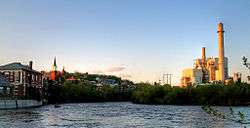Mill town
A mill town, also known as factory town or mill village, is typically a settlement that developed around one or more mills or factories, usually cotton mills or factories producing textiles.
United Kingdom
In the United Kingdom, the term "mill town" usually refers to the 19th century textile manufacturing towns of northern England and the Scottish Lowlands, particularly those in Lancashire (cotton) and Yorkshire (wool).
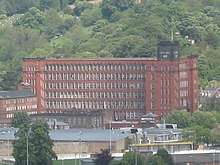
Some former mill towns have a symbol of the textile industry in their town badge. Some towns may have statues dedicated to textile workers (e.g. Colne[1]) or have a symbol in the badge of local schools (e.g. Ossett School).
| County | Towns |
|---|---|
| Cheshire mill towns | |
| Derbyshire mill towns | |
| Greater Manchester mill towns |
Ashton-under-Lyne, Bolton, Bury, Chadderton, Failsworth, Heywood, Hyde, Lees, Leigh, Manchester, Middleton, Oldham, Radcliffe, Ramsbottom, Reddish, Rochdale, Royton, Shaw and Crompton, Stalybridge, Stockport, Wigan |
| Lancashire mill towns |
Accrington, Bacup, Barnoldswick, Blackburn, Burnley, Calder Vale, Chorley, Colne, Darwen, Nelson, Oakenclough, Padiham, Preston for others see table below. |
| Yorkshire mill towns |
Batley, Bingley, Bradford, Brighouse, Cleckheaton, Dewsbury, Elland, Halifax, Hebden Bridge, Heckmondwike, Holmfirth, Huddersfield, Keighley, Morley, Mytholmroyd, Ossett, Pudsey, Shipley, Skipton, Sowerby Bridge, Todmorden, Yeadon |
The list below includes some towns where textiles was not the predominant industry. For example, mining was a key industry in Wigan and Leigh in Greater Manchester, and in Ossett in Yorkshire.
Spindleage of Lancashire mill towns producing spun cotton between 1830 and 1962
| Date | 1883 | 1893 | 1903 | 1913 | 1923 | 1926 | 1933 | 1944 | 1953 | 1962 |
|---|---|---|---|---|---|---|---|---|---|---|
| Accrington | 590 | 438 | 467 | 660 | 191 | 718 | 469 | 287 | 152 | 92 |
| Ashton | 1,574 | 1,731 | 1,781 | 1,955 | 1898 | 1,144 | 644 | 633 | 182 | |
| Blackburn | 1,671 | 1,398 | 1,321 | 1,280 | 1,224 | 1,071 | 672 | 451 | 309 | 103 |
| Bolton | 4,086 | 4,770 | 5,457 | 6,797 | 7,371 | 7,842 | 7,507 | 6,204 | 4,886 | 1,772 |
| Burnley | 1,126 | 734 | 667 | 563 | 538 | 507 | 240 | 182 | 144 | 14 |
| Bury | 875 | 899 | 833 | 955 | 1050 | 1000 | 745 | 630 | 524 | 268 |
| Chorley | 552 | 527 | 541 | 856 | 838 | 837 | 739 | 491 | 397 | 122 |
| Farnworth | 557 | 779 | 966 | 1,485 | 1,478 | 1,484 | 1,344 | 1,237 | 1,104 | 162 |
| Glossop | 1,106 | 1,158 | 968 | 882 | 821 | 839 | 524 | 204 | 154 | 10 |
| Heywood | 660 | 887 | 836 | 1,070 | 1,100 | 1,096 | 864 | 545 | 533 | 68 |
| Hyde | 590 | 499 | 533 | 741 | 793 | 696 | 475 | 366 | 337 | 58 |
| Leigh | 1,337 | 1,514 | 1,679 | 2,445 | 2,761 | 2,925 | 2,891 | 2,615 | 2,336 | 548 |
| Manchester | 2,445 | 2,353, | 2,225 | 3,703 | 3,307 | 3,439 | 3,417 | 2,974 | 1,934 | 271 |
| Middleton | 498 | 494 | 645 | 1,278 | 1,268 | 1,252 | 1,041 | 1,193 | 923 | 161 |
| Mossley | 1,153 | 1,217 | 1,033 | 1,288 | 1,297 | 1,289 | 371 | 264 | 256 | - |
| Oldham | 9,311 | 11,159 | 12,230 | 16,909 | 17,231 | 17,669 | 13,732 | 8,948 | 7,621 | 2,478 |
| Preston | 2,146 | 1,883 | 2,074 | 2,161 | 1,997 | 1,965 | 1,592 | 1,146 | 1,024 | 278 |
| Rochdale | 1,627 | 1,835 | 2,422 | 3,645 | 3,749 | 3,793 | 3,539 | 2,459 | 1,936 | 983 |
| Stalybridge | 1,083 | 1,157 | 1,027 | 1,236 | 1,104 | 1,103 | 801 | 483 | 426 | 122 |
| Stockport | 1,601 | 1,742 | 1,568 | 2,266 | 2,382 | 1,924 | 1,427 | 1,141 | 154 | |
| Wigan | 864 | 775 | 888 | 1,085 | 1,123 | 1,141 | 922 | 681 | 575 | 352 |
On his tour of northern England in 1849, Scottish publisher Angus Reach said:
In general, these towns wear a monotonous sameness of aspect, physical and moral... In fact, the social condition of the different town populations is almost as much alike as the material appearance of the tall chimneys under which they live. Here and there the height of the latter may differ by a few rounds of brick, but in all essential respects, a description of one is a description of all.[3]
— Angus Reach, Morning Chronicle, 1849
Italy
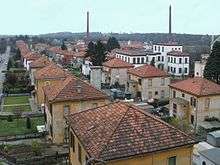
Poland

Żyrardów
The town grew out of a textile factory founded in 1833 by the sons of Feliks Lubienski, who owned the land where it was built. They brought in a specialist from France and his newly designed machines. He was French inventor, Philippe de Girard from Lourmarin. He became a director of the firm.[8] The factory town developed during the 19th century into a significant textile mill town in Poland. In honour of Girard, 'Ruda Guzowska' as the original estate was called, was renamed Żyrardów, a toponym derived of the polonised spelling of Girard's name.
Most of Żyrardów's monuments are located in the manufacturing area which dates from the 19th and early 20th centuries. It is widely believed that Żyrardów's textile settlement is the only entire urban industrial complex from the 19th-century to be preserved in Europe.
United States
New England
Beginning with Samuel Slater and technological information smuggled out of England by Francis Cabot Lowell, large mills were established in New England in the early to mid 19th century. Mill towns, sometimes planned, built and owned as a company town, grew in the shadow of the industries. The region became a manufacturing powerhouse along rivers like the Housatonic, Quinebaug, Shetucket, Blackstone, Merrimack, Nashua, Cocheco, Saco, Androscoggin, Kennebec or Winooski.
In the 20th century, alternatives to water power were developed, and it became more profitable for companies to manufacture textiles in southern states where cotton was grown and winters did not require significant heating costs. Finally, the Great Depression acted as a catalyst that sent several struggling New England firms into bankruptcy.
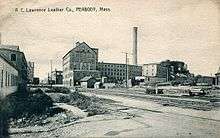
 Assawaga Mill, Dayville, CT, in 1909
Assawaga Mill, Dayville, CT, in 1909 American Thread Co. Mill, Willimantic, CT, c. 1910
American Thread Co. Mill, Willimantic, CT, c. 1910 Hollingsworth & Whitney Paper Mill, Waterville, ME, c. 1920
Hollingsworth & Whitney Paper Mill, Waterville, ME, c. 1920 Cumberland Mills, Westbrook, ME, c. 1902
Cumberland Mills, Westbrook, ME, c. 1902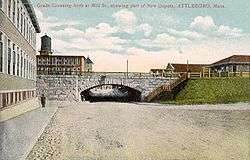 Mill Street, Attleboro, MA, in 1908
Mill Street, Attleboro, MA, in 1908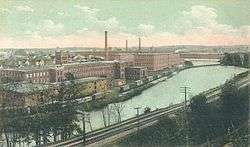 Arlington Mills, Lawrence, MA, in 1907
Arlington Mills, Lawrence, MA, in 1907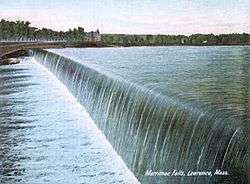 Merrimack Falls, Lawrence, MA, c. 1905
Merrimack Falls, Lawrence, MA, c. 1905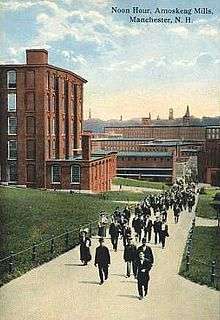 Amoskeag Mills, Manchester, NH, c. 1912
Amoskeag Mills, Manchester, NH, c. 1912 Jackson Mills, Nashua, NH, in 1907
Jackson Mills, Nashua, NH, in 1907 Alice Mills, Woonsocket, RI, in 1911
Alice Mills, Woonsocket, RI, in 1911 Colchester Mills, Winooski, VT, in 1907
Colchester Mills, Winooski, VT, in 1907
Mid-Atlantic
Laurel Mill (Laurel Factory)
| State | Towns |
|---|---|
| Maryland mill towns |
Ellicott City, Jerusalem, Oella, Owings Mills, Savage |
| New Jersey mill towns | |
South
 Model Mill Settlement, Chadwick Mills, Charlotte, N.C. Published c. 1905–1915
Model Mill Settlement, Chadwick Mills, Charlotte, N.C. Published c. 1905–1915 White Oak Cotton Mills, Greensboro, N.C. c. 1914
White Oak Cotton Mills, Greensboro, N.C. c. 1914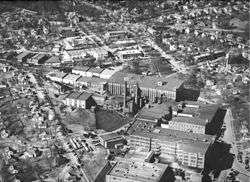 Aerial view of Ware Shoals Mill
Aerial view of Ware Shoals Mill
Sawmill towns
| State | Towns |
|---|---|
| Illinois | Carrier Mills, Harrisburg |
| Oregon | Roseburg |
| Washington | Longview |
| Wisconsin | Eau Claire |
South America
Colombia
See also
References
- "Steel statue tribute of mill girl". BBC. 24 July 2018.
- Williams, Mike; Farnie (1992). Cotton Mills of Greater Manchester. Carnegie Publishing. ISBN 0-9487898-9-1.CS1 maint: ref=harv (link)
- Powell, Rob (1986). In the Wake of King Cotton. Rochdale Art Gallery. p. 12.
- "Crespi D'Adda UNESCO – Sito ufficiale" (in Italian). Retrieved 5 February 2019.
- "Associazione Amici della Scuola del Villaggio Leumann" (in Italian). Retrieved 5 February 2019.
- "Abitare a Saronno tra '800 e '900" (PDF) (in Italian). Retrieved 5 February 2019.
- "Villaggio operaio della Filatura" (in Italian). Retrieved 5 February 2019.
- Chisholm, Hugh, ed. (1911). "Girard, Philippe Henri de". Encyclopædia Britannica (11th ed.). Cambridge University Press.
- WRITER, ALAN BURKE STAFF. "Leather goes to War at Peabody's Leather Museum".
- "Peabody Institute Library : Online Collections". peabodylibrary.pastperfectonline.com.
External links
Museums and historic sites
- American Textile History Museum, Lowell, MA
- Belknap Mill Society Museum, Laconia, NH
- Berlin and Coös County Historical Society, Berlin, NH
- Slater Mill Historic Site, Pawtucket, RI
- Lowell National Historic Park, Lowell, MA
- Lynn Heritage State Park, Lynn, MA
- The Millyard Museum, Manchester, NH
- Quinebaug & Shetucket Rivers Valley National Historic Corridor
- San Jose de Suaita Cotton Mill Museum
- Southern Textile Heritage Corridor, Vir, NC, SC, Ga, Al
- Museum Lewiston-Auburn, Lewiston, ME
